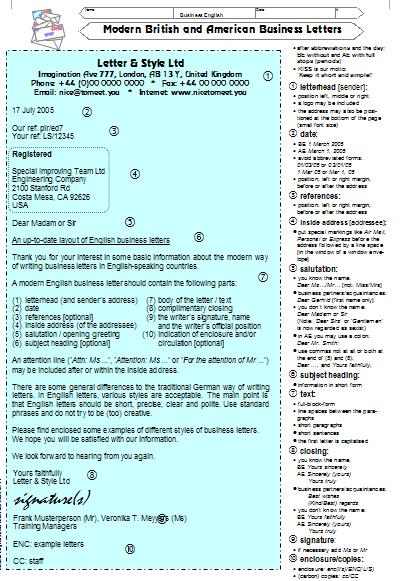Business letter
This article's tone or style may not reflect the encyclopedic tone used on Wikipedia. |
A business letter is a letter written in a formal language, usually used when writing from one business organization to another, or for correspondence between such organizations and their customers, clients and other external parties. Business letters usually follow a block format.
Parts of a Business Letter
Business Letters in the United States usually contain the following information (in this order):
- Letterhead or sender's address
- Date
- Inside address
- Greeting
- Letter body
- Complimentary closing
- Signature, printed name, and position of sender
In some situations, a business letter may also include the following optional information:
- Reference (RE:)
- Carbon Copy Recipients (CC:)
- Enclosures (ENC:)
- Reference Initials
Business Letter Layout Guidelines
Addresses
The address is generally written from the most specific information (i.e. the recipient's name) to the most general (i.e. the city, state, ZIP Code or country). If you know the recipient's gender, include a courtesy title (Mr. or Ms.).
Example of Address Line:
| Mr. Bill Duffy |
| Director of Marketing |
| Acme Industrial, Inc. |
| PO Box 148761 |
| Shirley, New York 11967 |
Dates
The date typically goes before the inside address. In formal business writing, it is best to completely write out the date to avoid confusion. For example, you should write October 8, 2002 instead of 10/8/02. One reason for writing out the date is because 10/8/02 is August 10, 2002 in some countries. You do not need to include the 'th', 'st' or 'rd' at the end of the number for the day.
Salutation
The salutation addresses the reader of your letter. It follows one of the following formats: 'Dear [Courtesy Title (Mr., Ms., Mrs., Dr., etc.)] [Name]' or 'Dear [Title]'. The salutation is followed by a colon in formal writing or a comma in informal writing. Do not include a courtesy title if you do not know the gender of the recipient. Keep in mind that many names are gender neutral.
Greetings and endings
The word ‘dear’ always comes before the name of the person you are writing to, even if you don’t know them. However, what follows after ‘dear’ determines how you are going to write the ending of your business letter.
If your letter begins ‘Dear Ms Foster’, ‘Dear Gary Stewart’, ‘Dear Wendy’, etc, then your letter should end with ‘Yours sincerely’.
If your letter is informal or neutral in style and you know the person fairly well, then you can use ‘Best wishes’, or ‘Kind regards’ instead.
If you do not know the name of the person you are writing to then your greeting should be ‘Dear Sir or Madam’ and your ending should be ‘Yours faithfully’.
In the US, any business letter may end with 'Sincerely, [Sender's Name]', but is not limited to that. Some may end with 'Sincerely Yours, [Sender's Name]' Yours Truly, [Sender's Name], etc. depending on the relationship.
Headings
It is always best to give a heading to a business letter. This helps to ensure that your letter is dealt with as efficiently as possible.
Headings come immediately after the greeting, and should be underlined or typed in bold. Make your heading brief and specific. For example:
Dear Sir or Madam,
Closure of bank account no. 56777889
I would like to inform you ……..
Different countries, different styles
Culture and society influence styles. Especially in the German speaking countries, formal rules are considered very important. An extreme example is the German industrial norm DIN 5008, which prescribes how to write German business letters in every detail from letterhead to closing as shown below and as explained in German here.
Examples:
These two examples from business trainings at schools are used to show how nice formal letters look.
Modern British and American business letter:
Please note that this is a voluntary style, not a "must".
Modern German business letter:
Please note this example shows what is mandatory according to the German industrial norm.
Another example of an English business letter
External links
- Business Letter Generator - Online form that can be used to download a block-style business letter


